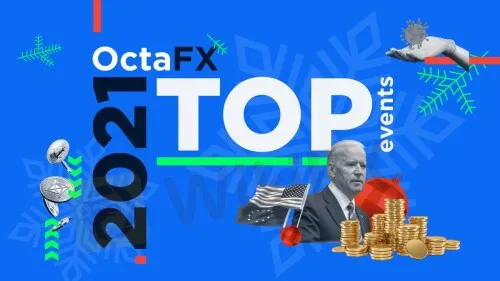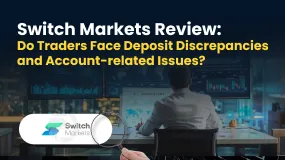简体中文
繁體中文
English
Pусский
日本語
ภาษาไทย
Tiếng Việt
Bahasa Indonesia
Español
हिन्दी
Filippiiniläinen
Français
Deutsch
Português
Türkçe
한국어
العربية
OctaFX Releases List of Top 2021 Events that Affected the Financial Market
Abstract:The year 2021 was packed with exciting developments and meaningful circumstances in world affairs—its economy, politics, and policies—impacting the financial sector as a whole. With the help of its analytics team, the international Forex broker OctaFX compiled a basic rundown to deliver some of the more critical, vital events which it deemed especially important.

The U.S. dollar's tumultuous journey through quantitative easing (QE)
During the COVID-19 crisis, the U.S. Federal Reserve (Fed) and the European Central Bank (ECB)—the central banks that issue the world's reserve currencies—flooded the financial markets with new money. The official reason stated was helping the suffering economy because of the pandemic.
Therefore, U.S. president Joe Biden's proposal of a 1.9 trillion USD stimulus package to Congress arrived on 21 January. The Republican Party was highly sceptical about this approach—some congressmen even recalled the already worrying, continual growth of the national debt (a mass total of 21.6 trillion USD at the time). It is a long-term development whose lack of resolution as of yet does not shake the market's firm belief in the reliability of the U.S. dollar.
Biden follows suit by signing stimulus plan
Fast forward two months, the U.S. Senate (6 March) and the U.S. House of Representatives (10 March) both approved the stimulus plan before Biden signed it on 11 March as a 1.9 trillion USD economic rescue package. Far from being a bipartisan undertaking, no Republican approved the new order. Although, the document was amended, for example, the clause on raising the minimum wage was removed. New money flooding the market like this filled most market participants with a bullish sentiment.
Another 1.2 trillion USD for 'infrastructure spending plan'
Towards the end of June 2021, expectations for a tight monetary policy were running high but then the U.S. Senate agreed on and approved a new 'infrastructure spending plan', totalling another 1.2 trillion USD. The reason was a sharp increase in inflation in the months prior to June.
Both institutions—the Fed and the ECB—have kept rates at zero or negative and implemented quantitative easing (QE) throughout 2021, increasing their balance sheets and buying bonds with that money. Because of this, their yields fell, which encouraged investors to put capital into companies' stocks and look for other projects.
Fed announces the end of bailout measures
In September, the U.S. Federal Reserve officially declared that it is ready to end its quantitative easing programme and may raise the base rate already from 2022 rather than 2023, as previously assumed. The Fed further added it would continue to buy 120 billion USD worth of assets each month for the time being: 80 billion USD in treasuries and 40 billion USD in mortgage-backed bonds.
The regulator's rhetoric initially spooked investors, but overseas markets moved higher on 23 September. The American S&P 500 was recovering from a marginal fall and rose by 1%. Finally, the U.S. monetary regulator started winding down asset purchases from the market to 105 billion USD in November (from 120 billion USD previously) and to 90 billion USD in December—strong signals for the market that the economy starts to revitalise itself.
Bitcoin reaches historic ATH in April before falling again by 53%
The whole of April, the crypto industry radiated with enthusiasm over an ongoing bull market before bitcoin—surprisingly to most—started a steep correction from a historical all-time high of 63,500 USD (13 April 2021) to 34,600 USD (29 May 2021). In those first initial waves downward, due to triggered margin calls, around 8 billion USD in position liquidations took place. This process had put most of the trading community on a new kind of alertness.
This downtrend continued up to 20 July 2021, reaching a price of 29,600 USD per bitcoin (that's over 53% from the previous all-time high). Only after that point did an uptrend start with a late-summer high of 52,600 USD (6 September 2021). Most were sure the bottom for bitcoin back then had been hit and more frequent but careful trading resumed during that time.
Ethereum stays strong but stable while bitcoin tops twice more
Six weeks later, the mother of all cryptocurrencies topped off its previous all-time high twice in close succession—65,990 USD (20 October 2021) and 67,500 USD (8 November 2021), vindicating a suspected bull market across market observers, retail investors, and legacy institutions once again. All the while, the altcoin market soldiered on with a fluctuating performance, seeing Ethereum's persistence and some success stories such as the Solana smart-contract platform. The latter rose from 1.84 USD on 1 January to its all-time high of 258.93 USD on 6 November, gaining 13,972%. Many opportunities for lucrative trades and initial long-term investments were realised. At the same time, some solid altcoin projects stagnated during this period, only showing that their turn for growth has yet to come.
U.S. and E.U. prioritise the basic materials sector
In autumn, the E.U. and the U.S. have agreed to suspend duties on steel and aluminium products. During a speech, the President of the European Commission, Ursula von der Leyen, stressed that her institution planned to develop proposals to suspend duties imposed on goods from the U.S. She elaborated that this would bring trade in steel and aluminium products back to their levels before these tariffs were imposed in 2018.
U.S. President Joe Biden reiterated the intentions of the European Union and the United States jointly committing to a carbon-based agreement on steel and aluminium trade. After President Trump's era of 'economic isolationism', many investors in the relevant industries understood this development as a bullish long-term sign.
European Union at a crossroads
In 2021's fourth quarter, the euro fell to its lowest value since the start of July 2020. The reason for the plunge was the worsening business climate in the E.U.
In Germany, supply problems within most industries have worsened. Berlin, as the fourth-biggest economy in the world, also inaugurated its new government in December. One important aim of the new coalition is to introduce a wide variety of new taxes on secondary homeownership and carbon emissions on all levels, be it corporate or private. Germany is a major player in the European Union's power dynamics structure. Its new government in Berlin will have much to say about the way onwards in terms of the continent's financial and political development.
What the future holds
As Powell hinted throughout the year, in January 2022 there will be a monthly quantitative easing cap of 60 billion USD, halving the 2021 rate and initiating a probable and gradual farewell to the emergency policy. A process that market participants of all shapes and sizes (private and corporate) will have to pay close attention to.
All of the dynamics above will have exciting new developments in 2022 and the years after—many of which will hit most by surprise. So, financial education and constant research and training towards economic and financial literacy are paramount to navigating through these fast-paced markets. This plain truth applies just as much to Foreign Exchange as it does to the stock market or the cryptocurrency domain.

Disclaimer:
The views in this article only represent the author's personal views, and do not constitute investment advice on this platform. This platform does not guarantee the accuracy, completeness and timeliness of the information in the article, and will not be liable for any loss caused by the use of or reliance on the information in the article.
Read more

Cloudflare Outage Disrupts Broker Websites and Crypto Platforms
Cloudflare outage causes widespread disruption to broker websites and crypto platforms, highlighting risks in web infrastructure reliance.

Interactive Brokers Expands Access to Taipei Exchange
Interactive Brokers adds Taipei Exchange trading, giving clients access to equities, ETFs, and TDRs with seamless FX conversion and Asian market exposure.

IG Group Expands French Stock Trading with Upvest
IG Group partners with Upvest to launch stock and ETF trading in France, boosting its European expansion amid rising broker competition.

Switch Markets Review: Do Traders Face Deposit Discrepancies and Account-related Issues?
Do you fail to deposit your funds into the Switch Markets forex trading account? Earned profits, withdrew them too, but did Switch Markets block your deposits? Wanted to close your trading account due to payment-related issues, but in turn got your emails blocked by the Australia-based forex broker? Faced a negative trading account balance because of illegitimate trade order execution? Many traders have shared these stories about Switch Markets on broker review platforms. In this Switch Markets review article, we have mentioned the same. Read on!
WikiFX Broker
Latest News
Trillium Financial Broker Exposed: Top Reasons Why Traders are Losing Trust Here
FIBO Group Ltd Review 2025: Find out whether FIBO Group Is Legit or Scam?
Amillex Withdrawal Problems
Is INGOT Brokers Safe or Scam? Critical 2025 Safety Review & Red Flags
150 Years Of Data Destroy Democrat Dogma On Tariffs: Fed Study Finds They Lower, Not Raise, Inflation
CQG Partners with Webull Singapore to Power the Broker’s New Futures Trading Offering
【WikiEXPO Global Expert Interviews】Ashish Kumar Singh: Building a Responsible and Interoperable Web3
Trump: India\s US exports jump despite 50% tariffs as trade tensions ease
IEXS Review 2025: A Complete Expert Analysis
CySEC Flags 21 Unauthorized Broker Websites in 2025 Crackdown
Currency Calculator




